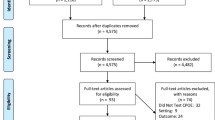ABSTRACT
BACKGROUND
Several physician organizations and the Centers for Medicare and Medicaid Services (CMS) support compliance measures for written discharge instructions. CMS has identified clear discharge instructions with specific attention to medication management as a necessary intervention.
OBJECTIVE
We tested the hypothesis that implementing a standardized electronic discharge instructions document with embedded computerized medication reconciliation would decrease post-discharge hospital utilization.
DESIGN
Retrospective pre- and post-implementation comparison cohort study.
PATIENTS
Subjects were hospitalized patients age 18 and older discharged between November 1, 2005 and October 31, 2006 (n = 16,572) and between March 1, 2007 and February 28, 2008 (n = 17,516).
INTERVENTION
Implementation of a standardized, templated electronic discharge instructions document with embedded computerized medication reconciliation on December 18, 2006.
MAIN MEASURES
The primary outcome was a composite variable of readmission or Emergency Department (ED) visit within 30 days of discharge. Secondary outcomes were the individual variables of readmissions and ED visits within 30 days.
KEY RESULTS
The implementation of standardized electronic discharge instructions with embedded computerized medication reconciliation was not associated with a change in the primary composite outcome (adjusted OR 1.04, 95% CI 0.98–1.10) or the secondary outcome of 30-day ED visits (adjusted OR 0.98, 95% CI 0.98–1.10). There was an unexpected small but statistically significant increase in 30-day readmissions (adjusted OR 1.08, 95% CI 1.01–1.16).
CONCLUSIONS
Implementation of standardized electronic discharge instructions was not associated with reduction in post-discharge hospital utilization. More studies are needed to determine the reasons for post-discharge hospital utilization and to examine outcomes associated with proposed process-related recommendations.
Similar content being viewed by others
REFERENCES
Jencks SF, Williams MV, Coleman EA. Rehospitalizations among patients in the Medicare fee-for-service program. N Engl J Med. 2009;360:1418–28.
Makaryus AN, Friedman EA. Patients' understanding of their treatment plans and diagnosis at discharge. Mayo Clin Proc. 2005;80:991–4.
Coleman EA, Smith JD, Raha D, Min SJ. Posthospital medication discrepancies: prevalence and contributing factors. Arch Intern Med. 2005;165:1842–7.
Witherington EM, Pirzada OM, Avery AJ. Communication gaps and readmissions to hospital for patients aged 75 years and older: observational study. Qual Saf Health Care. 2008;17:71–5.
Centers for Medicare and Medicaid Services. Application of incentives to reduce avoidable readmissions to hospitals. Fed Regist. 2008;73:23673–5.
Snow V, Beck D, Budnitz T, et al. Transitions of Care Consensus Policy Statement American College of Physicians-Society of General Internal Medicine-Society of Hospital Medicine-American Geriatrics Society-American College of Emergency Physicians-Society of Academic Emergency Medicine. J Gen Intern Med. 2009;24:971–6.
VanSuch M, Naessens JM, Stroebel RJ, Huddleston JM, Williams AR. Effect of discharge instructions on readmission of hospitalised patients with heart failure: do all of the Joint Commission on Accreditation of Healthcare Organizations heart failure core measures reflect better care? Qual Saf Health Care. 2006;15:414–7.
Jha AK, Orav EJ, Epstein AM. Public reporting of discharge planning and rates of readmissions. N Engl J Med. 2009;361:2637–45.
Balaban RB, Weissman JS, Samuel PA, Woolhandler S. Redefining and redesigning hospital discharge to enhance patient care: a randomized controlled study. J Gen Intern Med. 2008;23:1228–33.
Coleman EA, Parry C, Chalmers S, Min SJ. The care transitions intervention: results of a randomized controlled trial. Arch Intern Med. 2006;166:1822–8.
Jack BW, Chetty VK, Anthony D, et al. A reengineered hospital discharge program to decrease rehospitalization: a randomized trial. Ann Intern Med. 2009;150:178–87.
Nelson EA, Maruish ME, Axler JL. Effects of discharge planning and compliance with outpatient appointments on readmission rates. Psychiatr Serv. 2000;51:885–9.
Friedman B, Jiang HJ, Elixhauser A. Costly hospital readmissions and complex chronic illness. Inquiry. 2008;45:408–21.
Hernandez C, Jansa M, Vidal M, et al. The burden of chronic disorders on hospital admissions prompts the need for new modalities of care: a cross-sectional analysis in a tertiary hospital. QJM. 2009;102:193–202.
Grafft CA, McDonald FS, Ruud KL, Liesinger JT, Johnson MG, Naessens JM. Effect of hospital follow-up appointment on clinical event outcomes and mortality. Arch Intern Med. 2010;170:955–60.
Ingarfield SL, Finn JC, Jacobs IG, et al. Use of emergency departments by older people from residential care: a population based study. Age Ageing. 2009;38:314–8.
Graumlich JF, Novotny NL, Nace GS. Patient readmissions, emergency visits, and adverse events after software-assisted discharge from hospital: cluster randomized trial. J Hosp Med. 2009;4:E11–9.
Acknowledgements
Cynthia Chuang MD, MSc, is funded, in part, by the Eunice Kennedy Shriver National Institute of Child Health and Human Development (K23 051634).
Conflict of Interest
None disclosed.
Author information
Authors and Affiliations
Corresponding author
Rights and permissions
About this article
Cite this article
Showalter, J.W., Rafferty, C.M., Swallow, N.A. et al. Effect of Standardized Electronic Discharge Instructions on Post-Discharge Hospital Utilization. J GEN INTERN MED 26, 718–723 (2011). https://doi.org/10.1007/s11606-011-1712-y
Received:
Revised:
Accepted:
Published:
Issue Date:
DOI: https://doi.org/10.1007/s11606-011-1712-y




